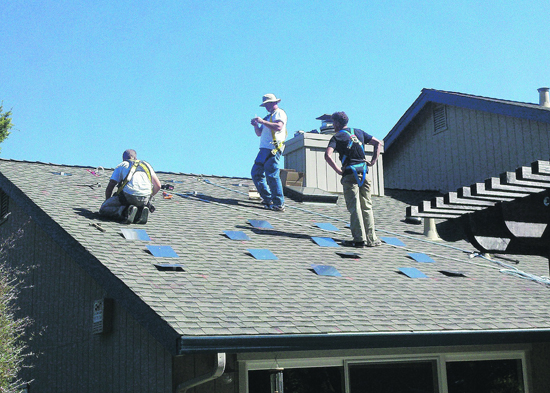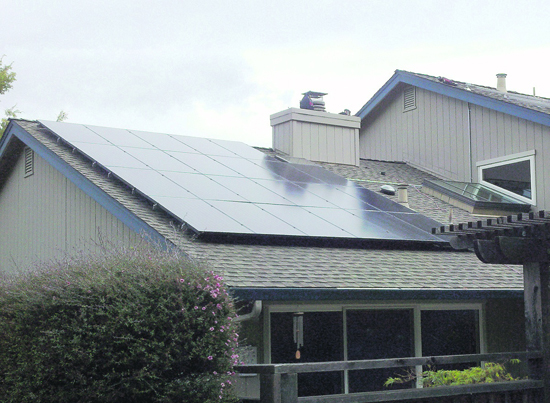 | | | Measuring the roof Photo provided
| | | | | |
In sunny climates - like most of Lamorinda - your roof might actually be a valuable piece of real estate. This year, we decided to put ours to use and go into the renewable energy business...by putting up solar panels.
 Solar power is not cheap. But neither is traditional electricity, if you use more than the bare minimum. If you study your bill, you'll notice that PG&E sells you both low-priced electricity (enough to keep your lights on and food cold), and really expensive energy (the juice you might be using to power your plasma TV, hot tub, pond, air conditioner, desktop computers, and cable box). In our house, the first 330 kWh/month cost only $40. But the last 330 kWh? That runs us another $120. And if you are thinking about getting a plug in Prius or Chevy Volt (350 kWh per 1000 miles), or adding a hot tub - you'll be paying a lot, even with special off-peak rates available for electric vehicles. Solar power is not cheap. But neither is traditional electricity, if you use more than the bare minimum. If you study your bill, you'll notice that PG&E sells you both low-priced electricity (enough to keep your lights on and food cold), and really expensive energy (the juice you might be using to power your plasma TV, hot tub, pond, air conditioner, desktop computers, and cable box). In our house, the first 330 kWh/month cost only $40. But the last 330 kWh? That runs us another $120. And if you are thinking about getting a plug in Prius or Chevy Volt (350 kWh per 1000 miles), or adding a hot tub - you'll be paying a lot, even with special off-peak rates available for electric vehicles.
 So if you hate paying big energy bills, or simply feel badly about gobbling up more than you share of the grid, you can either conserve like crazy or add solar.
So if you hate paying big energy bills, or simply feel badly about gobbling up more than you share of the grid, you can either conserve like crazy or add solar.
 It turns out that going solar is both maddeningly complicated and surprisingly easy. There are quite a few variables to consider- including which solar panels and inverter, how big a system, how much sun your roof gets, whether your electrical panel is suitable, tax credits, utility subsidies, upfront investment vs. discounted future cash flow, and so on. Fortunately, there are a number of entrepreneurial firms that want to make solar easier for consumers, by removing the risk and taking on the gauntlet of complexity. Some of the leading firms are Solar City, Sungevity, Sun Run, and the Solar Company. They all follow the same basic business model, acting as a "one call does it all" system designer, master contractor, and financing specialist.
It turns out that going solar is both maddeningly complicated and surprisingly easy. There are quite a few variables to consider- including which solar panels and inverter, how big a system, how much sun your roof gets, whether your electrical panel is suitable, tax credits, utility subsidies, upfront investment vs. discounted future cash flow, and so on. Fortunately, there are a number of entrepreneurial firms that want to make solar easier for consumers, by removing the risk and taking on the gauntlet of complexity. Some of the leading firms are Solar City, Sungevity, Sun Run, and the Solar Company. They all follow the same basic business model, acting as a "one call does it all" system designer, master contractor, and financing specialist.
 We contacted two companies. Each has a website that asked for our typical electrical bill and basic roof info, and used Google-earth style mapping software to determine if we were good candidates, and how big a system would be needed. The key is that they don't just calculate how much energy you can produce, but also compare it to both the costs and government incentives associated with the system.
We contacted two companies. Each has a website that asked for our typical electrical bill and basic roof info, and used Google-earth style mapping software to determine if we were good candidates, and how big a system would be needed. The key is that they don't just calculate how much energy you can produce, but also compare it to both the costs and government incentives associated with the system.
 Here's where a word of caution is necessary: Virtually all solar firms make aggressive assumptions in calculating your savings/benefits vs. costs. The most common practice is to assume that your energy bill will rise 4 to 5% per year over the next 10-20 years, which is a plausible possible scenario, but by no means the only one, particularly as appliances, heating, and lighting become more energy efficient. At least one solar firm also factors in the expected increase in the home's value - the same fool's gold that has launched a thousand other home improvement projects.
Here's where a word of caution is necessary: Virtually all solar firms make aggressive assumptions in calculating your savings/benefits vs. costs. The most common practice is to assume that your energy bill will rise 4 to 5% per year over the next 10-20 years, which is a plausible possible scenario, but by no means the only one, particularly as appliances, heating, and lighting become more energy efficient. At least one solar firm also factors in the expected increase in the home's value - the same fool's gold that has launched a thousand other home improvement projects.
 Oddly, one company said our location was too shaded to generate enough power, while another was quite confident that we could. To start the process we gave them our last 12 months of energy bills, and they sent an inspector out to look at our roof (you need to have enough roof life left, enough space, and the right angles.) They then designed a system and generated several quotes for us for different leasing and purchase options. We chose a 10-year prepay lease, since this option made them responsible for system maintenance, gives us flexibility down the road, and included a guaranteed minimum output, which was particularly important given the mixed messages we received about our location.
Oddly, one company said our location was too shaded to generate enough power, while another was quite confident that we could. To start the process we gave them our last 12 months of energy bills, and they sent an inspector out to look at our roof (you need to have enough roof life left, enough space, and the right angles.) They then designed a system and generated several quotes for us for different leasing and purchase options. We chose a 10-year prepay lease, since this option made them responsible for system maintenance, gives us flexibility down the road, and included a guaranteed minimum output, which was particularly important given the mixed messages we received about our location.
 The process took several months, including getting sign off from our neighbors (as part of our HOA), system design, city permitting, applying to PG&E, and an inspection of our electrical system. The actual installation only took a few days, but was followed by another month of waiting for meter hookup and PG&E approval. The process took several months, including getting sign off from our neighbors (as part of our HOA), system design, city permitting, applying to PG&E, and an inspection of our electrical system. The actual installation only took a few days, but was followed by another month of waiting for meter hookup and PG&E approval.
 Now, we get the pleasure of our meter telling us when we are feeding rather than consuming from the grid, and an oddly satisfying web monitoring tool, which tracks our production by the hour.
Now, we get the pleasure of our meter telling us when we are feeding rather than consuming from the grid, and an oddly satisfying web monitoring tool, which tracks our production by the hour.
 The impact on climate change is moderate (the equivalent of driving 4000 miles less per year), as is the expected financial return (more or less like buying a 10-year CD that pays 4% interest.) But we are hedged against any price/energy shocks, and have the psychic benefit of knowing that we are in a small way helping build a green economy.
The impact on climate change is moderate (the equivalent of driving 4000 miles less per year), as is the expected financial return (more or less like buying a 10-year CD that pays 4% interest.) But we are hedged against any price/energy shocks, and have the psychic benefit of knowing that we are in a small way helping build a green economy.
 Information on the all of the solar companies mentioned is available on the web.
Information on the all of the solar companies mentioned is available on the web.

|

